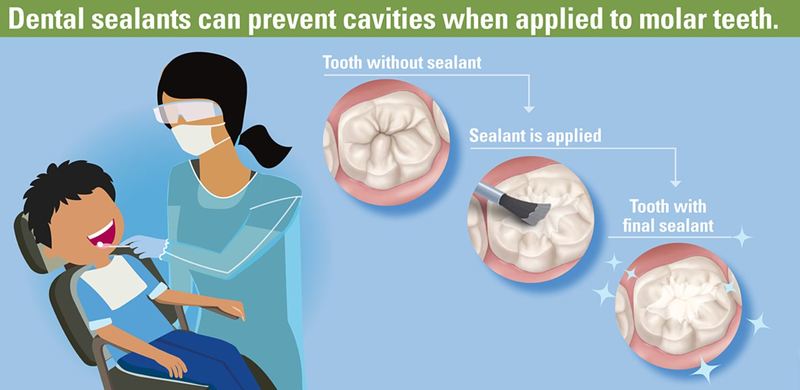
Dental sealant safety for children’s oral health is a much-researched topic today. Dental sealants are protective coatings applied to the molars and premolars to prevent bacteria and food particles from getting trapped, making it easier for children to clean their teeth and reduce the risk of tooth decay. These sealants have been extensively studied and approved by organizations like the American Dental Association, assuring their safety. They are made of non-toxic plastic material and are safe for children to have in their mouths.
Dental Sealants Safety in Children
Dental sealants are a safe and effective means to shield your child’s teeth from cavities. They have been proven to prevent tooth decay and are a durable preventive measure, but they should be applied by a qualified dentist to ensure dental sealant safety.

Are Dental Sealants Safe for My Child?
Today we will explore the safety of dental sealants for children and address any concerns you may have.
What are Dental Sealants?
- Purpose of Dental Sealants:
- Dental sealants are thin, plastic coatings.
- They are applied to the chewing surfaces of molars and premolars, which have deep grooves and pits.
- Protection Against Tooth Decay:
- These grooves and pits can easily trap food particles and bacteria.
- Sealants act as a protective barrier to prevent cavities by sealing off these vulnerable areas.
- Timing of Application:
- Sealants are typically applied to permanent teeth.
- This is done as soon as they erupt, which commonly occurs between the ages of 6 and 12.
- Consideration for Primary Teeth:
- In some cases, dentists may recommend sealants for primary (baby) teeth.
- This recommendation is more likely if the child is at a higher risk of developing cavities.
Dental Sealants Safety, True?
Here are the key points about the safety of dental sealants for children:
- Endorsement by Dental Authorities:
- The American Dental Association (ADA), the Centers for Disease Control and Prevention (CDC), and the Food and Drug Administration (FDA) all support the use of dental sealants as an effective method to prevent tooth decay in children.
- Rigorous Material Testing:
- The materials used in dental sealants undergo thorough testing and have received approval for use in dental care.
- BPA-Free Plastic:
- Dental sealants are typically made from plastic that is free of bisphenol A (BPA). This addresses concerns related to potential BPA exposure.
- Trace Amounts of BPA:
- While BPA can be found in various consumer products, the trace amounts used in dental sealants have not been demonstrated to cause any harm.
The Application Process
Applying dental sealants is a quick and painless procedure that can usually be done during a routine dental visit. Here is a step-by-step guide to the application process:
1. Cleaning: The dentist or dental hygienist will clean the teeth thoroughly to remove any debris or plaque.
2. Isolation: The teeth are isolated and kept dry to ensure the sealant adheres properly.
3. Conditioning: A gentle acid solution is applied to the chewing surfaces of the teeth to create a rough surface for the sealant to bond to.
4. Application: The dentist or hygienist will paint the sealant material onto the teeth. It flows into the grooves and pits, forming a protective layer.
5. Curing: A special light is used to harden the sealant, making it durable and long-lasting.
Once the sealants are in place, they can last for several years with proper oral hygiene and regular dental check-ups. The dentist will evaluate the sealants during each visit and reapply them if necessary.
Benefits of Dental Sealants
Dental sealants offer several benefits for children:
1. Preventing Cavities: Sealants create a physical barrier that prevents food particles and bacteria from accumulating in the deep grooves of the teeth, reducing the risk of cavities.
2. Easy to Maintain: Sealants are smooth and easy to clean, making it easier for children to keep their teeth clean and free from plaque.
3. Cost-Effective: Investing in sealants can save money in the long run by reducing the need for more extensive dental treatments, such as fillings or crowns.
4. Non-Invasive: Sealants do not require any drilling or removal of tooth structure. The application process is painless and does not require anesthesia.
5. Long-Lasting Protection: With proper care, sealants can provide protection against cavities for many years.
Are There Any Risks?
While dental sealants are generally safe, there are a few considerations to keep in mind:
1. Allergic Reactions: Some individuals may have an allergic reaction to the materials used in sealants. If you or your child has a known allergy to certain plastics or dental materials, it’s important to discuss this with your dentist before getting sealants.
2. Sealant Wear and Tear: Over time, sealants can wear down or chip off, leaving the tooth vulnerable to decay. Regular dental check-ups are essential to monitor the condition of the sealants and make any necessary repairs or replacements.
3. Proper Placement: The success of sealants depends on proper placement. If the sealants are not applied correctly or if the tooth surface is not adequately prepared, they may not provide optimal protection. That’s why it’s crucial to choose an experienced dentist who specializes in pediatric dentistry.
In conclusion, dental sealants are a safe and effective preventive measure to protect your child’s teeth from cavities. They have been endorsed by reputable dental organizations and are made of BPA-free materials. The application process is quick and painless, and the benefits of sealants outweigh the minimal risks associated with them. Talk to your child’s dentist to determine if dental sealants are a suitable option for your child’s oral health.
Key Takeaways: Are Dental Sealants Safe for My Child?
- Dental sealants are a safe and effective way to protect your child’s teeth from cavities.
- They are made of a thin plastic material that is applied to the chewing surfaces of the back teeth.
- Sealants act as a barrier, preventing bacteria and food particles from getting trapped in the grooves of the teeth.
- They are painless to apply and do not require any drilling or numbing.
- Research has shown that sealants can reduce the risk of cavities by up to 80%.
Frequently Asked Questions
1. What are dental sealants and how do they work?
Dental sealants are a protective coating, typically applied to molars and premolars, using a thin plastic-like material that smooths out the tooth’s chewing surface. By filling in grooves and pits, this barrier makes teeth easier to clean.
The applied sealant serves as a safeguard against bacterial and food particle entrapment in tooth crevices, subsequently lowering the likelihood of decay and cavities. Overall, dental sealants provide a safe and effective solution to shield your child’s teeth from tooth decay.
2. Are dental sealants safe for my child?
Yes, dental sealants are considered safe for children. The sealant material used is non-toxic and does not contain any harmful chemicals. It is applied directly to the teeth and does not enter the bloodstream or affect other parts of the body.
However, it is important to note that dental sealants should only be applied by a qualified dentist or dental hygienist.
3. At what age should my child get dental sealants?
- Optimal Timing: The best time to apply dental sealants to your child’s teeth is when their permanent molars and premolars emerge, typically occurring between the ages of 6 and 12.
- Immediate Protection: Applying sealants as soon as these teeth appear provides immediate protection against cavities by creating a barrier against bacteria and food particles.
- Application to Adult Teeth: While commonly used on children’s teeth, dental sealants can also be applied to adult teeth, especially if they are cavity-prone or possess deep grooves that are challenging to clean.
- Dentist’s Recommendation: Your dentist will evaluate your child’s teeth and advise on the appropriate timing for sealant application based on their specific oral health needs.
4. How long do dental sealants last?
Dental sealants can last for several years with proper care. On average, sealants can last up to 10 years. However, it is important to have regular dental check-ups to ensure the sealants are still intact and functioning effectively.
Good oral hygiene practices, such as brushing twice a day, flossing, and regular dental cleanings, can help prolong the lifespan of dental sealants.
5. Are there any risks or side effects associated with dental sealants?
Dental sealants are generally safe and well-tolerated. However, there can be minor side effects such as temporary sensitivity or discomfort after the application. These symptoms usually subside within a few days.
In rare cases, an allergic reaction to the sealant material may occur. If your child experiences any unusual symptoms or discomfort after getting dental sealants, it is important to contact your dentist for further evaluation and guidance.
Dental Sealants for Kids with Dr. Staci Whitman
Final Thoughts on the Dental Sealants Safety for Your Child
Dental sealants are a secure and effective preventive measure for your child’s oral health, supported by extensive research and expert consensus. These sealants create a protective shield against tooth decay and cavities. Concerns about potential BPA exposure in sealants have been addressed by the American Dental Association (ADA), which affirms the minimal risk, emphasizing the superior benefits of sealants. Dental professionals also uphold stringent safety standards during application.
In summary, dental sealants are a safe and valuable choice for preserving your child’s oral health. They offer lasting protection, reducing the need for invasive dental procedures. Opting for sealants demonstrates a responsible commitment to your child’s dental well-being, backed by professional expertise and robust research. Your child’s radiant smile will benefit from this proactive choice.
Call or Book appointment online
:Ace Dental Care Alpharetta office: 678-562-1555 - Book Now
Ace Dental Care Norcross office: 770-806-1255 - Book Now
Disclaimer
This blog post was generated by artificial intelligence. The content of this post may not be accurate or complete, and should not be relied upon as a substitute for professional advice. If you have any questions about the content of this post, please contact us.
We are constantly working to improve the accuracy and quality of our AI-generated content. However, there may still be errors or inaccuracies. We apologize for any inconvenience this may cause.





